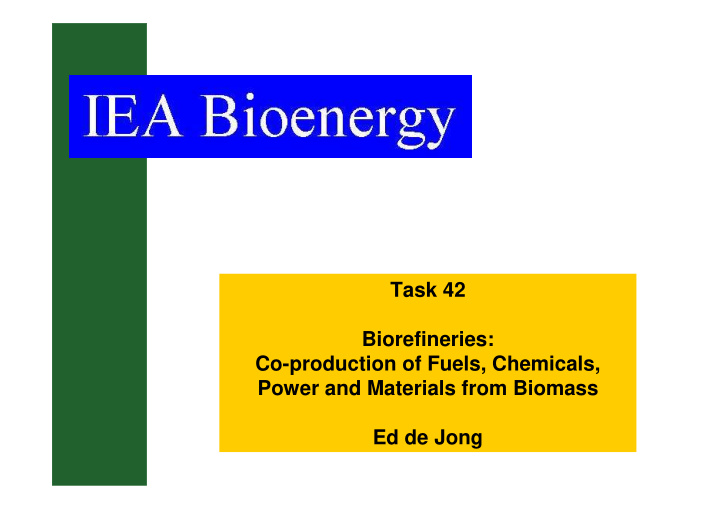



Task 42 Biorefineries: Co-production of Fuels, Chemicals, Power and Materials from Biomass Ed de Jong
Facilitating commercialisation and market deployment of environmentally sound, sustainable and cost-competitive bioenergy technologies………
IEA Bioenergy…….. • Set up in 1978 by the International Energy Agency • Provides an international forum for sharing information and developing best practice on – Technology development – Non-technical barriers and issues – Regulatory and legislative issues • Produces authoritative scientific and technical information on key strategic issues affecting deployment • One of two Implementing Agreements with major relevance for Biofuels (the other IEA-AMF (Advanced Motor Fuels)) • Annual budget 1.7 M US-$ (2007)
Vision and Mission Vision: To accelerate the use of environmentally sound and cost- competitive bioenergy on a sustainable basis, to provide increased security of supply and a substantial contribution to future energy demands. Mission: To facilitate commercialisation and market deployment of environmentally sound, sustainable and cost-competitive bioenergy technologies.
Strategy To provide platforms for international collaboration and information exchange in bioenergy research, development and demonstration. This includes: • the development of networks, • dissemination of information, • involvement of industry and • encouragement of membership by countries with a strong bioenergy infrastructure
22 Contracting Parties • Australia • Ireland • Austria • Italy • Belgium • Japan • Brazil • Netherlands • Canada • New Zealand • Croatia • Norway • Denmark • South Africa • European • Sweden Commission • Switzerland • Finland • United Kingdom • France • United States • Germany
Tasks • Feedstock Forest and agricultural products, MSW and recovered fuels • Conversion Combustion, gasification, pyrolysis, anaerobic digestion, fermentation, biorefineries • Integrating Research Issues GHG balances, socioeconomic drivers, international trade, systems analysis
Task 42: Biorefineries Focus on: Biorefinery as a facility that optimises the integrated production of materials, fuels, energy and chemicals and so maximises the value derived from the biomass feedstock. Aims to: Assess the worldwide position and potential of biorefineries. Gather new insights of the possibilities for the simultaneous manufacture of transportation fuels, added value chemicals, heat, power and materials.
Task 42 on Biorefineries IEA Bioenergy Position Task within IEA Bioenergy Task 33 international national Task 32 RD&D RD&D Thermal Task 29 Biomass programmes programmes gasification cofiring Socio- Task 30 of biomass economic SRC drivers Task 38 Task 40 Greenhouse Biorefineries Sustainable gas international Task 42 balances biomass trade Task 41 System Task 31 Task 37 analysis Sustainable Biogas EU Task 39 Task 34 forestry Technology Liquid fuels Pyrolysis Platforms from of biomass biomass
Partners Task 42 Founding members: Austria, Canada, Denmark, EU, France, Germany, Ireland, the Netherlands New Members: 2009: Australia, Italy 2010: USA, New Zealand 10
Task 42: Key Activities and Achievements • Development of a common definition for biorefineries. • Development of a common classification system for biorefineries. • Country reports on current processing potential and mapping of existing plants. • Identification of biorefinery related RD&D programmes in participant countries. • Annual biorefinery seminar for stakeholders. • Linking of ongoing international activities through joint events and new initiatives
Task 42 Definition on Biorefineries: Biorefinery: the sustainable processing of biomass into a spectrum of marketable products and energy • Biorefinery : concepts, facilities, plants, processes, clusters of industries • Sustainable : maximizing economics, - social aspects, minimizing environmental impacts, fossil fuel replacement, closed cycles • Processing : upstream processing, transformation, fractionation, thermo-chemical and biochemical conversion, extraction, separation, downstream processing • Biomass : wood & agricultural crops, organic residues, forest residues, aquatic biomass • Spectrum : multiple energic and non-energic outlets • Marketable : Present and forecasted (volume and prices) • Products : both intermediates and final products (i.e. food, feed, materials, chemicals, fuels, power, heat)
Biorefinery 13
Development of a common classification system for biorefineries 14
Rationale biorefinery system classification method The classification approach consists on four main features: Feedstocks: • energy crops from agriculture (e.g. starch crops, short rotation forestry) • biomass residues from agriculture, forestry, trade and industry conversion processes Conversion Processes: • biochemical (e.g. fermentation, enzymatic conversion) • thermo-chemical (e.g. gasification, pyrolysis) • chemical (e.g. acid hydrolysis, synthesis, esterification) • mechanical processes (e.g. fractionation, pressing, size reduction) Platforms: • (e.g. C5/C6 sugars, syngas, biogas) Energy/products: • energy (e.g. bioethanol, biodiesel, synthetic biofuels) • products (e.g. chemicals, materials, food and feed)
Application of the classification to biorefinery systems 16
Network on which the biorefinery system classification method is based 18
Further reading: Paper in BioFPR ( in press ) Classification 19
Biorefinery Brochure
Status March 2009 Website: www.IEA-Bioenergy.Task42- 1) Biorefineries.com 2) Classification of Biorefineries 3) Country reports on Biorefineries 4) Leaflet 5) Brochure with examples of biorefineries
Thank you for your attention Further information: Ed de Jong (ed.dejong@avantium.com) Rene van Ree (rene.vanree@wur.nl) 22
Recommend
More recommend